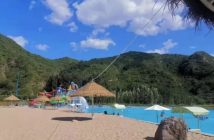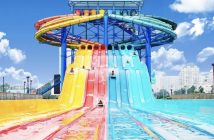
The Beijing National Aquatics Center (北京国家游泳中心), better known as the Water Cube, stands as a monument to the swimming competitions of the 2008 Beijing Summer Olympics. It was in the confines of this immense bubble-covered structure that thousands of fans cheered on as Michael Phelps won eight gold medals and beat the world record for the 100m butterfly event.
But now, with the sounds of cheering long gone, what has become of “the fastest Olympic pool in the world”? Even with all its speed, has the Water Cube been able to out-swim the curse of irrelevance so frequently visited upon other former Olympic venues?

The answer, quite fortunately, is yes. The Water Cube has been in almost constant use since 2009, when it was opened to the public on certain days of the week. From ordinary swim tests to lavish weddings, The Water Cube has seen it all. Formerly filled with the graceful moments of professional swimmers, the bubble-clad behemoth has even been host to grace of a different kind: a stunning production of Tchaikovsky’s Swan Lake. More than a few jewelers and other artists have taken the graceful curves of the foamy edifice as inspiration for a plethora of souvenirs.
The Water Cube’s stint as a performance hall didn’t last long; the frothy structure was closed to the public in October of 2009 in order ready the complex for yet another transformation. This time, a fragment of the complex would become a water park. Reopened in early August of 2010, on the 2-year anniversary of the 2008 Beijing Summer Olympics, the redesigned facility became Happy Magic Water Cube Park.
 Where Olympic athletes once gathered to discuss strategies, smaller, slightly less professional swimmers now giggle and splash as plastic bubbles and jellyfish float through the air. The park takes up 12,000sqm of the former Olympic venue and features 13 water slides and rides, not to mention the wave pool and a lazy river. In addition, 60 or so lifeguards watch over the enormous park. As if that weren’t enough, there is even a spa area for exhausted parents. The Olympic pool has been left intact for swimming matches, and other areas of the park are available for exercise and various events.
Where Olympic athletes once gathered to discuss strategies, smaller, slightly less professional swimmers now giggle and splash as plastic bubbles and jellyfish float through the air. The park takes up 12,000sqm of the former Olympic venue and features 13 water slides and rides, not to mention the wave pool and a lazy river. In addition, 60 or so lifeguards watch over the enormous park. As if that weren’t enough, there is even a spa area for exhausted parents. The Olympic pool has been left intact for swimming matches, and other areas of the park are available for exercise and various events.
Just in time for the 2012 London Summer Olympics, this post is part of a series called “Where Are They Now?”, which explores what became of four 2008 Beijing Summer Olympics venues: The Bird’s Nest, The Water Cube, the Beach Volleyball Ground at Chaoyang Park, and Shunyi Olympic Rowing-Canoeing Park. This is the second installment of the series.
Photos (in order of appearance): Sophie Zhu (1) and Dina Mao (2 and 3)



